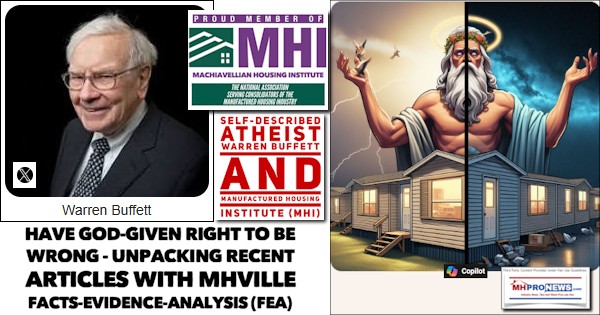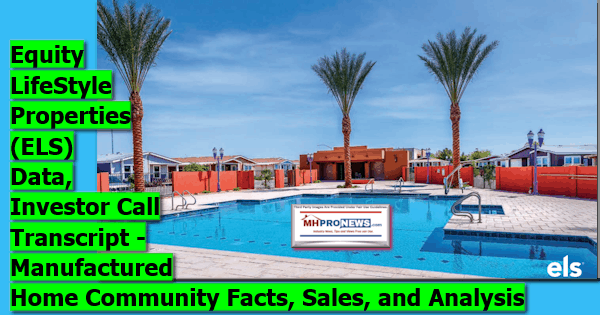
Equity LifeStyle Properties (ELS) has some two hundred high quality manufactured home communities. It is one of the top REITs – Real Estate Investment Trusts – in the manufactured housing industry today. What ensues will utilize a process that follows these steps.
- This preface.
- The released dividends press release plus the most recent earnings call transcript, as edited by the provider.
- Graphics from the sources as shown.
- Pull quotes from what follows.
- Analysis of those statements and quotes by Manufactured Home Professional News (MHProNews) with commentary and linked information that should signal areas of interest, opportunities, concerns, and more.
This is also part two of a report that began at the link below. That report is largely graphical, and can be quickly viewed via the linked text and image below.
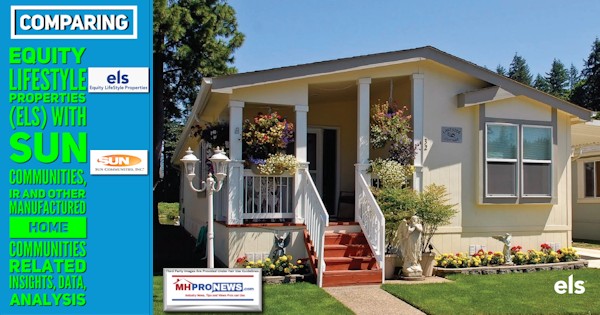
With that methodology and forward, let’s begin.
ELS Announces 2020 Dividends
Press Release, according to Business Wire, on October 29, 2019
The Board of Directors of Equity LifeStyle Properties, Inc. (ELS) (referred to herein as “we,” “us,” and “our”) has approved setting the annual dividend rate for 2020 at $1.37 per common share, an increase of $0.145 over the current $1.225 per common share for 2019. Our Board of Directors, in its sole discretion, will determine the amount of each quarterly dividend in advance of payment.
We also declared a fourth quarter 2019 dividend of $0.30625 per common share, representing, on an annualized basis, a dividend of $1.225 per common share. The dividend will be paid on January 10, 2020 to stockholders of record at the close of business on December 27, 2019.
This press release includes certain “forward-looking statements” within the meaning of the Private Securities Litigation Reform Act of 1995. When used, words such as “anticipate,” “expect,” “believe,” “project,” “intend,” “may be” and “will be” and similar words or phrases, or the negative thereof, unless the context requires otherwise, are intended to identify forward- looking statements and may include without limitation, information regarding our expectations, goals or intentions regarding the future, and the expected effect of our acquisitions. These forward-looking statements are subject to numerous assumptions, risks and uncertainties, including, but not limited to:
- our ability to control costs and real estate market conditions, our ability to retain customers, the actual use of sites by customers and our success in acquiring new customers at our properties (including those that we may acquire);
- our ability to maintain historical or increase future rental rates and occupancy with respect to properties currently owned or that we may acquire;
- our ability to retain and attract customers renewing, upgrading and entering right- to-use-contracts;
- our assumptions about rental and home sales markets;
- our ability to manage counter-party risk;
- our ability to renew our insurance policies at existing rates and on consistent terms;
- in the age-qualified properties, home sales results could be impacted by the ability of potential home buyers to sell their existing residences as well as by financial, credit and capital markets volatility;
- results from home sales and occupancy will continue to be impacted by local economic conditions, lack of affordable manufactured home financing and competition from alternative housing options including site-built single-family housing;
- impact of government intervention to stabilize site-built single-family housing and not manufactured housing;
- effective integration of recent acquisitions and our estimates regarding the future performance of recent acquisitions;
- the completion of future transactions in their entirety, if any, and timing and effective integration with respect thereto;
- unanticipated costs or unforeseen liabilities associated with recent acquisitions;
- ability to obtain financing or refinance existing debt on favorable terms or at all;
- the effect of interest rates;
- the effect from any breach of our, or any of our vendors’, data management systems;
- the dilutive effects of issuing additional securities;
- the outcome of pending or future lawsuits or actions brought against us, including those disclosed in our filings with the Securities and Exchange Commission; and
- other risks indicated from time to time in our filings with the Securities and Exchange Commission.
For further information on these and other factors that could impact us and the statements contained herein, refer to our filings with the Securities and Exchange Commission, including “Risk Factors” in our most recent Annual Report on Form 10-K and subsequent quarterly reports on Form 10-Q.
These forward-looking statements are based on management’s present expectations and beliefs about future events. As with any projection or forecast, these statements are inherently susceptible to uncertainty and changes in circumstances. We are under no obligation to, and expressly disclaim any obligation to, update or alter our forward-looking statements whether as a result of such changes, new information, subsequent events or otherwise.
We own or have an interest in 413 quality properties in 33 states and British Columbia consisting of 156,081 sites. We are a self-administered, self-managed, real estate investment trust with headquarters in Chicago.
###
Next up, is the edited transcript of their earnings conference call.
Edited Transcript of ELS earnings conference call or presentation 22-Oct-19 3:00pm GMT

Q3 2019 Equity LifeStyle Properties Inc Earnings Call
NEW YORK Oct 23, 2019 (Thomson StreetEvents) — Edited Transcript of Equity LifeStyle Properties Inc earnings conference call or presentation Tuesday, October 22, 2019 at 3:00:00pm GMT
TEXT version of Transcript
================================================================================
Corporate Participants
================================================================================
* Marguerite M. Nader
Equity LifeStyle Properties, Inc. – President, CEO & Director
* Patrick Waite
Equity LifeStyle Properties, Inc. – Executive VP & COO
* Paul Seavey
Equity LifeStyle Properties, Inc. – Executive VP, Treasurer & CFO
================================================================================
Conference Call Participants
================================================================================
* Andrew T. Babin
Robert W. Baird & Co. Incorporated, Research Division – Senior Research Analyst
* John Joseph Pawlowski
Green Street Advisors, LLC, Research Division – Analyst
* Joshua Dennerlein
BofA Merrill Lynch, Research Division – Research Analyst
* Michael Bilerman
Citigroup Inc, Research Division – MD and Head of the US Real Estate and Lodging Research
* Nicholas Gregory Joseph
Citigroup Inc, Research Division – Director & Senior Analyst
* Piljung Kim
BMO Capital Markets Equity Research – Senior Real Estate Analyst
* Samir Upadhyay Khanal
Evercore ISI Institutional Equities, Research Division – MD & Equity Research Analyst
* Todd Jakobsen Stender
Wells Fargo Securities, LLC, Research Division – Director & Senior Analyst
================================================================================
Presentation
——————————————————————————–
Operator [1]
——————————————————————————–
Good day, everyone, and thank you for joining us to discuss Equity LifeStyle Properties third quarter 2019 results. Our featured speakers today are Marguerite Nader, our President and CEO; Paul Seavey, our Executive Vice President and CFO; and Patrick Waite, our Executive Vice President and COO.
In advance of today’s call, management released earnings. (Operator Instructions) As a reminder, this call is being recorded.
Certain matters discussed during this conference may contain forward-looking statements in the meanings of the federal securities laws. Our forward-looking statements are subject to certain economic risk and uncertainty. The company assumes no obligation to update or supplement any statements that become untrue because of subsequent events.
In addition, during today’s call, we will discuss non-GAAP financial measures as defined by SEC Regulation G. Reconciliations of these non-GAAP financial measures to the comparable GAAP financial measures are included in our earnings release, our supplemental information and our historical SEC filings.
At this time, I’d like to turn the call over to Marguerite Nader, our President and CEO.
——————————————————————————–
Marguerite M. Nader, Equity LifeStyle Properties, Inc. – President, CEO & Director [2]
——————————————————————————–
Good morning, and thank you for joining us for our third quarter earnings call. Today, we will be focused on a detailed review of our third quarter results, our initial 2020 guidance and our rationale for the recommended 2020 dividend increase.
Our third quarter results, released yesterday, show strong quarter and year-to-date trends. Year-to-date, we increased occupancy by 262 sites, and this quarter marks our 40th consecutive quarter of occupancy growth. The home sale market was strong as evidenced by our rental conversions and resale activity. Our online transaction activity continues to escalate. In the quarter, our RV revenue booked through our website increased 19%, and our sales of online camping passes increased by 25%.
Our summer marketing campaigns resulted in an increase in fans and followers to a current base of over 625,000. These followers are converting to loyal customers. Our RV revenue, including Thousand Trails, has grown 5.6% year-to-date. This growth has been fueled by growth in our annual income and our Thousand Trails revenue. The annual growth of 6.1% is comprised of 5.2% rate and 90 basis points of occupancy. Our Thousand Trails portfolio revenue increased from both the dues revenue and upgrades. Year-to-date, we’ve seen an increase in sales of 12% and an increase of upgrades of 13%.
Turning to 2020. Each year, we finish our budget process in October and provide detailed projections for the following year. We have issued guidance of $2.22 at the midpoint for next year, which is 6.1% growth rate in FFO per share. Seasonal and transient activity require additional visibility to be able to forecast with more accuracy. As is our practice, we will update guidance each quarter as we have more knowledge about reservations at the property level.
Our MH and RV properties continue to experience heightened demand as seen in occupancy and rate growth. Our team members work with the homeowners to determine best use of capital investment within each asset. Within our MH portfolio, by the end of October, we will have noticed 50% of our residents for rent increases and anticipate 4.4% growth in MH revenue. Our RV revenue is anticipated to increase 5.2%. Strength in our RV annual base along with strong performance in Thousand Trails are the main contributors to this projection.
Our product is in demand and the demographic trends are in our favor. Baby Boomers are relocating to our key states and the demand can be seen in the increased online and on-property activity. Additionally, we are seeing an increased number of multigenerational customers. We now have customers who have vacationed at our properties, bringing their children and grandchildren. This exposure to the millennial and Gen X demographic will be helpful in filling our future long-term customer pipeline. Millennials now represent 26% of RV buyers and millennials and Gen X combined represent more than half of RV buyers.
I would like to update you on our proposed 2020 dividend policy. The dividend policy is a Board-level decision that is typically made at our fourth quarter Board of Directors meeting. We feel it’s helpful to highlight management’s recommendations and rationale with respect to the dividend. Historically, we have been able to take advantage of opportunities due to the free cash flow generated by our operations. Consistent with the — in the past, in 2020, we expect to have in excess of $53 million of discretionary capital after meeting our obligations for dividend payments, recurring capital expenditures and principal payments. Each year, to arrive at a recommendation, we review our projected growth in FFO and our outstanding obligations with the goal of maintaining our underlying financial flexibility. In addition, we stress test our future obligations to ensure we can continue to meet both our financial obligations and our customer expectations.
The stress test reveals the strength of our balance sheet, which has been fortified over the years with longer-term maturities. Currently, our average term to maturity is 12 years, which is double the REIT sector average. We are focused on long-term value creation. The stability and growth of our cash flow, our solid balance sheet and the strong underlying trends in our business have led our management team to recommend a 12% increase in our dividend to $1.37 for 2020. We’ve increased our dividend significantly over the last few years. To give a little history, over the past 5 years, we have increased our dividend 83%. Please note that while this is management’s recommendation, the Board has not yet approved this recommendation.
Our team members continue to deliver a great experience to our customers. I appreciate their hard work, and I look forward to the start of the snowbird season as we welcome back our residents and guests for the winter season.
I will now turn it over to Paul to walk through the numbers in detail.
——————————————————————————–
Paul Seavey, Equity LifeStyle Properties, Inc. – Executive VP, Treasurer & CFO [3]
——————————————————————————–
Thanks, Marguerite, and good morning, everyone. I will review our third quarter results, discuss our guidance assumptions for the remainder of 2019 as well as our preliminary guidance for 2020 and provide some comments about our balance sheet. Please note that all per share remarks reflect our recent 2-for-1 stock split.
We reported better-than-expected third quarter normalized FFO of $102.7 million or $0.53 per share. As a result of the completion of the Loggerhead Marina acquisition, other income was higher than expected because preferred distributions from our joint venture investment.
During the quarter, we also settled the remainder of our Hurricane Irma insurance claim. We recognized approximately $5.9 million of revenue that we’ve deducted from our calculation of normalized FFO.
Core base rental income was up 5.4% compared to last year with 4.7% coming from rate and 70 basis points coming from occupancy. We gained 58 occupied sites in the quarter as a result of increasing our homeowner count by 85 and reducing rental occupancy by 27.
Our core RV revenues were in line with guidance in the quarter. Annual and seasonal revenues showed strong growth of 6.2% and 3.9%, respectively. Rate increases for our annual customers contributed 5.5% with the remainder of our revenue growth generated from occupancy gains across the portfolio. Our transient demand remained strong as evidenced by the combined growth of our transient resort revenues and our membership subscriptions. In addition, transient site usage by members was up more than 10% in the quarter compared to last year. A limited number of locations within our RV footprint did not perform as expected, resulting in lower transient revenues and guidance during the quarter.
Membership subscriptions and upgrade sales revenues were higher than guidance in the quarter. During the quarter, we sold 5,900 Thousand Trails camping pass memberships. Year-to-date, our camping pass sales volume has increased 12% compared to last year. Upgrade sales volume in the quarter was 859 units at an average price of approximately $6,700. The net contribution from membership sales and expenses was higher than guidance mainly as a result of sales of our higher-cost upgrade product.
Utility and other income is in line with guidance and lower than last year because of insurance proceeds received in the third quarter of 2018. In the quarter, Core property operating maintenance and real estate tax expenses were higher than forecast mainly from repairs and maintenance and utility expenses. A portion of the variances in repairs and maintenance and utility expenses resulted from utility system repairs and related water usage. In addition, electric expenses were higher than forecast in all regions as weather patterns resulted in increased demand.
Finally, while the quarter was relatively mild on the storm front, we did incur close to $500,000 of storm-related expenses that contributed to our variance to guidance. Overall, core NOI before property management grew 5.1% in the quarter and year-to-date periods. NOI from noncore properties was $4.8 million in the quarter. This includes NOI from the Marina portfolio we announced closing in mid-September. Year-to-date, the acquisition properties in the noncore have performed as expected.
Property management and corporate G&A expenses were $23.3 million in the quarter. Other income was higher than guidance. Upon closing of the Marina acquisition, we recognized income from preferred distributions related to our joint venture investment that had previously been deferred. Financing costs of $25.5 million include interest expense on borrowings to fund our acquisition activity. Year-to-date, normalized FFO was $1.58 per share, a growth rate of 8.4% over 2018.
The press release and supplemental package provides fourth quarter and full year 2019 guidance in detail as well as preliminary 2020 guidance. As I discuss guidance, keep in mind, my remarks are intended to provide our current estimate of future results. All growth rates and revenue and expense projections represent midpoints in our guidance range. Our fourth quarter normalized FFO guidance is approximately $98.6 million or $0.51 per share at the midpoint of our guidance range. We expect core NOI growth of 4.6% in the fourth quarter to contribute to 4.9% core NOI growth for the full year. We assume no core MH occupancy gain during the quarter.
Looking ahead to the fourth quarter in our RV business, our current annual, seasonal and transient reservation pace is in line with our expectations. Page 17 of our earnings release shows historical and projected revenues from our membership business. We expect total revenues of $111.3 million in 2019, a growth rate of 7.5% over 2018. For the full year, we expect core revenue growth of 4.4% and core NOI growth of 4.9%. The impact of the Marina acquisition can be seen in the increase in noncore NOI, which is partially offset by increased interest expense. Other income and expense have been reduced as we will no longer receive preferred distributions from the Marina JV.
Full year normalized FFO at the midpoint of our guidance range is about $401 million or $2.09 per share, a growth rate of 7.9%. The midpoint of our preliminary guidance range for full year 2020 normalized FFO is approximately $426.4 million or $2.22 per share. This represents a 6.1% increase over 2019 normalized FFO per share. Growth in core NOI before property management is expected to be approximately 5.3%. Our projections of core NOI and normalized FFO growth for 2020 assume fourth quarter 2019 results will be consistent with our stated guidance. Consistent with our past practice, we plan to update guidance on our January call, and we may adjust growth rates on certain line items after we finalize results for 2019.
We assume no growth from incremental occupancy we may gain in our core MH properties during 2020. Base rent is expected to grow 4.4% with 4% coming from rate and 40 basis points from occupancy as a result of sites we filled in 2019. In our core RV resort business, we expect 5.1% growth in 2020. Our annual revenues are expected to represent more than 60% of our total RV revenues, and we expect 5.3% growth mainly as a result of increases in rate across our portfolio. We project 4.6% growth in seasonal revenues and 4.8% transient revenue growth.
During the first quarter, we expect to generate more than 50% of our seasonal revenue for the year and more than 20% of our transient revenue. Though the winter season is still weeks away, we considered our seasonal and transient reservation pace for the first quarter of 2020 when developing our guidance assumptions. As Marguerite mentioned, we have limited visibility into seasonal and transient revenues beyond the coming quarter. We intend to continue updating guidance throughout 2020 as we have better visibility into reservation trends.
Our budget assumes total revenue generated by our membership business will be $118.1 million as shown on Page 17 of the earnings release. We assume sales and activations of 42,700 Thousand Trails camping passes next year, an increase of 4.7%. We assume membership upgrade volume will exceed 3,000 at an average price of around $6,500.
Core property operating maintenance and real estate tax expenses are assumed to increase 3.1% in 2020. Our budget for repairs and maintenance expense assumes normal run rate operations. We have maintained our historical practice and have not assumed expenses related to property damage or other onetime items in our guidance. We do note that over the past few years, we have seen an increase in volatility related to weather events impact on our properties and the cost to maintain and repair assets as a result. We intend to continue to provide updates quarterly when these unexpected events occur.
Our guidance for noncore properties includes the expected contribution from the properties we’ve acquired during 2019. We assume no other acquisition activity in our 2020 guidance model. Our other income and expense budget reflects normal run rate income generated by our MH and RV joint ventures. As a reminder, in 2019, we recognized approximately $2 million of JV income related to a refinancing distribution from one of our joint ventures. Our guidance for financing costs and other includes the cost of debt to fund the Marina acquisition, but does not assume any impact from other future capital events.
Now I’ll comment on our balance sheet. We have no debt maturing during the remainder of 2019. In 2020, we have approximately $49 million of secured debt maturing in the second half of the year. Current secured debt terms are 10 years at coupons in the 3.5% to 4.25% range, 60% to 75% loan to value and 1.35 to 1.5x debt service coverage. GSEs and life companies continue to quote MH and RV deals at rates well inside CMBS. High-quality, age-qualified MH assets continue to command best financing terms. We continue to place high importance on balance sheet flexibility. Our interest coverage is 4.8x, and our line of credit has $280 million of availability with an accordion feature that provides $200 million of additional capacity.
Now we would like to open it up for questions.
================================================================================
Questions and Answers
——————————————————————————–
Operator [1]
——————————————————————————–
(Operator Instructions) Our first question comes from Nicholas Joseph with Citi.
——————————————————————————–
Nicholas Gregory Joseph, Citigroup Inc, Research Division – Director & Senior Analyst [2]
——————————————————————————–
What drove the decision to acquire your JV partner’s interest in the Marina portfolio? And then how has NOI performed relative to your expectations and versus MH and RV NOI growth?
——————————————————————————–
Marguerite M. Nader, Equity LifeStyle Properties, Inc. – President, CEO & Director [3]
——————————————————————————–
Sure. So we’ve been in the JV that included the Loggerhead portfolio over the last 2 years. And we’ve really had a chance to see how these top-tier properties have performed, and we were happy to be able to take over 100% ownership. That JV includes 11 coastal Marinas in Florida. These properties, they have a high degree of annual cash flow with over 80% of the revenue from annual site rent. We plan to operate these assets kind of side by side with our Florida location, and they really — they provide long-term stable cash flow. What we’ve seen from 2017, an increase of about 5% growth in NOI each year. And so it’s been some healthy growth in NOI. And overall, we’re pleased we are taking over the operations of the assets and pleased to be able to do that.
——————————————————————————–
Nicholas Gregory Joseph, Citigroup Inc, Research Division – Director & Senior Analyst [4]
——————————————————————————–
And is there an opportunity to acquire additional marinas? How large of exposure could you see your marina exposure growing to?
——————————————————————————–
Marguerite M. Nader, Equity LifeStyle Properties, Inc. – President, CEO & Director [5]
——————————————————————————–
There are about 4,500 marinas in the United States, 500 we will consider institutional quality. So — and there’s about 3 large owners that count for less than 5% of the overall revenue in the marina space. So it’s highly fragmented, I think much like what you’ve seen us do in the RV space, where there is marinas that have long-term cash flow that makes sense for us and are in locations that we like, you’d see us continue to buy.
——————————————————————————–
Operator [6]
——————————————————————————–
Our next question comes from John Kim of BMO Capital Markets.
——————————————————————————–
Piljung Kim, BMO Capital Markets Equity Research – Senior Real Estate Analyst [7]
——————————————————————————–
Just sticking with Loggerhead, what was the interest rate of the joint venture debt? And do you plan to refinance it or keep it unencumbered?
——————————————————————————–
Paul Seavey, Equity LifeStyle Properties, Inc. – Executive VP, Treasurer & CFO [8]
——————————————————————————–
The debt had to be paid off at closing. And so what we did, as you saw, was use our line of credit. And what we plan to do with respect to the marinas, really, we have the objective of developing secured lending relationships to finance the marinas that have quality and characteristics similar to this portfolio. The plan really is to execute in a manner similar to the experience that we had in 2004 when we entered the RV business. At that time, there was a select group of lenders and brokers that were familiar with underwriting RV resorts. And I put together a plan at that time to partner with those lenders and brokers, at the same time, educating others so that we could expand the network of available lenders. A key factor that helped us with that, accessing institutional debt capital for the RV space was showing the sticky relationships with customers and longer-term revenue streams that are really analogous to MH revenues. And we think that characteristics exist in the marina space and plan to build on past experience to expand the lending network for these assets.
——————————————————————————–
Piljung Kim, BMO Capital Markets Equity Research – Senior Real Estate Analyst [9]
——————————————————————————–
So what interest rate could you finance marina assets today versus MH or RVs?
——————————————————————————–
Paul Seavey, Equity LifeStyle Properties, Inc. – Executive VP, Treasurer & CFO [10]
——————————————————————————–
I think it’s a little early to say that. I think that as I mentioned, we’re 3.5% to kind of 4.25% in this space right now. And I’d say that there’s probably a bit of a spread to that pricing, but it’s a little bit early to talk specifics on what pricing would be.
——————————————————————————–
Piljung Kim, BMO Capital Markets Equity Research – Senior Real Estate Analyst [11]
——————————————————————————–
Okay. And then a question on MH occupancy. I guess you had 40 straight quarters of occupancy growth, which, I assume, is year-over-year because it’s been flat sequentially. And you’re not assuming any growth in occupancy in your 2020 guidance, which was consistent from last year. But how much room do you think is left on the occupancy fronts getting any potential increases from 95.4% today?
——————————————————————————–
Patrick Waite, Equity LifeStyle Properties, Inc. – Executive VP & COO [12]
——————————————————————————–
It’s Patrick. 54% of our properties are currently 98% to 100% occupied. So we see opportunity to continue to grow occupancy across the portfolio. Half of our vacancy is in Florida, which has got a really good demand profile in migration and has performed well for us. And we’re seeing strength even in the secondary markets like Las Vegas as an example, Minneapolis. So with a good demand profile and that occupancy profile, we’re looking at 46% of our properties with an opportunity to grow up to 98% and perhaps more.
——————————————————————————–
Marguerite M. Nader, Equity LifeStyle Properties, Inc. – President, CEO & Director [13]
——————————————————————————–
And as it relates to that 98%, the ones that are 98% occupied have been in that range for 10-plus years. So once it get to that level, it can certainly stay at that level.
——————————————————————————–
Piljung Kim, BMO Capital Markets Equity Research – Senior Real Estate Analyst [14]
——————————————————————————–
Can you comment on how many sites do you expect to add through expansions this year and in 2020?
——————————————————————————–
Marguerite M. Nader, Equity LifeStyle Properties, Inc. – President, CEO & Director [15]
——————————————————————————–
Sure. In ’19, about 1,000 sites and a similar number, 1,000 to 1,200 in 2020.
——————————————————————————–
Operator [16]
——————————————————————————–
Our next question comes from Drew Babin of Baird.
——————————————————————————–
Andrew T. Babin, Robert W. Baird & Co. Incorporated, Research Division – Senior Research Analyst [17]
——————————————————————————–
A question on your MH rate growth. Looks like it’s been trending towards the upper 4s versus maybe closer to 4% kind of in the past. Just curious whether there’s been a contribution there from ROI CapEx or is that just a product of your properties being more occupied and having more kind of traction to drive rate. Could you maybe decompose that a little bit?
——————————————————————————–
Marguerite M. Nader, Equity LifeStyle Properties, Inc. – President, CEO & Director [18]
——————————————————————————–
Yes. I think what we’re seeing there, and we’ve talked about a little bit in the past is that we meet with the homeowners’ association. We sit down and talk to them about what they would like to have happen at the property between events, amenity upgrades, just things that they’re interested in. And when we sit with them, at the same time, we talk about what the rate increase is, what the proposed rate increase, and we share with them what our market survey is. So how did we get there? And I think as a result of that and kind of adding that additional kind of CapEx or amenity feature to it has been helpful in getting to the numbers that you’ve seen us post. But effectively, we’re taking the CapEx dollars that we had allocated and then just discussing with our residents where the best use of that capital is.
——————————————————————————–
Andrew T. Babin, Robert W. Baird & Co. Incorporated, Research Division – Senior Research Analyst [19]
——————————————————————————–
Okay. And I guess one follow-up to that. It looks like 2020 guidance assumes a rate growth kind of reverts to that 4%. Is there anything behind that other than just kind of caution given that it’s early? Can we assume the same sort of assumptions when it comes to the CapEx projects you mentioned in kind of the overall environment?
——————————————————————————–
Paul Seavey, Equity LifeStyle Properties, Inc. – Executive VP, Treasurer & CFO [20]
——————————————————————————–
I think your observation is a reasonable one. I think that some of the contributors to the uptick in growth are the result of the discussions that Marguerite just mentioned. There’s also potentially an increase in rates on turnover and so forth that because we don’t dial-in increased occupancy that has contributed in the past. So there’s a possibility that those would contribute going forward.
——————————————————————————–
Andrew T. Babin, Robert W. Baird & Co. Incorporated, Research Division – Senior Research Analyst [21]
——————————————————————————–
Okay. Appreciate the color. And one more for me. It sounds like the marina business, looking into secured debt, there’s possibly some larger plans in it. I was just hoping you could talk about, as this business grows, if it grows, are there any accounting nuances or anything where that business maybe works a little differently than MH or RV that need to be dealt with and/or non-REIT income potentially coming from fuel sales, things like that. Maybe just expand on that a little bit? Maybe some of the unique challenges that come with potentially expanding in that business?
——————————————————————————–
Paul Seavey, Equity LifeStyle Properties, Inc. – Executive VP, Treasurer & CFO [22]
——————————————————————————–
Yes. I think similar to what we see in the RV business, there’s ancillary activity at the marinas fuel sales, as an example, that are not requalifying revenue streams. The structure that we have is for ownership at the marinas and operations of those businesses, it’s quite similar to the structure that we have in the RV business, and we pay very close attention to that of course. But I think that for purposes of debt underwriting, part of what we are working to educate lenders on and really develop a program around is the long-term revenue streams that Marguerite mentioned. That’s really — that was really the hallmark of our success in developing the RV program, and we anticipate that to continue on the marina program.
——————————————————————————–
Marguerite M. Nader, Equity LifeStyle Properties, Inc. – President, CEO & Director [23]
——————————————————————————–
And I think, Drew, what you could see inside on the marina side, just on — like the RV side, that you could have a highly transient marina that has a lot of ancillary revenue, and you would see us not interested in that, just like what you see on the RV side.
——————————————————————————–
Operator [24]
——————————————————————————–
Our next question comes from Todd Stender of Wells Fargo.
——————————————————————————–
Todd Jakobsen Stender, Wells Fargo Securities, LLC, Research Division – Director & Senior Analyst [25]
——————————————————————————–
Paul, just to stay on that theme, I’m guessing marinas aren’t able to tap agency debt. That’s fair to say, right?
——————————————————————————–
Paul Seavey, Equity LifeStyle Properties, Inc. – Executive VP, Treasurer & CFO [26]
——————————————————————————–
That is fair to say, yes.
——————————————————————————–
Todd Jakobsen Stender, Wells Fargo Securities, LLC, Research Division – Director & Senior Analyst [27]
——————————————————————————–
Yes. So you’ll stay in the secured side? I mean does this eventually open up the possibility if you can expand this property type of looking at more unsecured side?
——————————————————————————–
Paul Seavey, Equity LifeStyle Properties, Inc. – Executive VP, Treasurer & CFO [28]
——————————————————————————–
I’d say it’s something that’s evolving. I would caution everybody to remember, this is quite a small part of our business. I mean just in terms of total value, we’re talking about less than $200 million that has been invested. And so we’re going to be working on developing these relationships, exploring what the opportunities are and anticipate that we’ll have success with that. But I think we can provide you updates in future quarters as we make progress.
——————————————————————————–
Todd Jakobsen Stender, Wells Fargo Securities, LLC, Research Division – Director & Senior Analyst [29]
——————————————————————————–
All right. And just to highlight that piece of what you’ve invested so far. So your cost base is the original $30 million, the $49 million you just spent, plus the $72 million in debt?
——————————————————————————–
Paul Seavey, Equity LifeStyle Properties, Inc. – Executive VP, Treasurer & CFO [30]
——————————————————————————–
Well, the original was $35 million. There was the initial funding and then there was earnout. So there was $35 million plus the pieces that you mentioned.
——————————————————————————–
Todd Jakobsen Stender, Wells Fargo Securities, LLC, Research Division – Director & Senior Analyst [31]
——————————————————————————–
Got it. Okay. And then how about yield? Have you — I guess maybe if looking at, if you do, on an IRR basis for the last 2 years and what do you — how do you look at your going-in yield, I guess, on marinas?
——————————————————————————–
Marguerite M. Nader, Equity LifeStyle Properties, Inc. – President, CEO & Director [32]
——————————————————————————–
So what we had on these marinas, we had a preferred piece that was a 7% preferred, which we discussed at the time we entered into it. And this is a 6% cap rate on the transaction that we did.
——————————————————————————–
Todd Jakobsen Stender, Wells Fargo Securities, LLC, Research Division – Director & Senior Analyst [33]
——————————————————————————–
Got it. And I know it’s small, but if you do grow it, will you be breaking out revenues, expenses, NOI for the marinas?
——————————————————————————–
Paul Seavey, Equity LifeStyle Properties, Inc. – Executive VP, Treasurer & CFO [34]
——————————————————————————–
I think that we would look to report revenue streams similar to the marina business — similar to the RV business, I should say, the annual seasonal transient.
——————————————————————————–
Operator [35]
——————————————————————————–
Our next question comes from Joshua Dennerlein of Bank of America Merrill Lynch.
——————————————————————————–
Joshua Dennerlein, BofA Merrill Lynch, Research Division – Research Analyst [36]
——————————————————————————–
Just one follow-up on the marinas. You mentioned 5% NOI growth, how much of that was driven by rate versus occupancy gains?
——————————————————————————–
Marguerite M. Nader, Equity LifeStyle Properties, Inc. – President, CEO & Director [37]
——————————————————————————–
It was roughly half and half and — yes, so it’s roughly half, half.
——————————————————————————–
Joshua Dennerlein, BofA Merrill Lynch, Research Division – Research Analyst [38]
——————————————————————————–
So it was like a 2.5% rate increase per year that’s kind of…
——————————————————————————–
Marguerite M. Nader, Equity LifeStyle Properties, Inc. – President, CEO & Director [39]
——————————————————————————–
Right. That’s correct.
——————————————————————————–
Joshua Dennerlein, BofA Merrill Lynch, Research Division – Research Analyst [40]
——————————————————————————–
Okay. Okay. And then on the R&M expenses, I think you mentioned those were higher than kind of what you were forecasting. Is that all storm-related or was there something else going on there as well?
——————————————————————————–
Paul Seavey, Equity LifeStyle Properties, Inc. – Executive VP, Treasurer & CFO [41]
——————————————————————————–
No. As I mentioned, we had expenses coming from some water system repairs in the quarter and related utility expenses. And then the electric expense has elevated, just elevated demand really. And about $0.5 million was related to storm activity.
——————————————————————————–
Joshua Dennerlein, BofA Merrill Lynch, Research Division – Research Analyst [42]
——————————————————————————–
Okay. Okay. And you expect that to kind of normalize, I guess, going forward?
——————————————————————————–
Paul Seavey, Equity LifeStyle Properties, Inc. – Executive VP, Treasurer & CFO [43]
——————————————————————————–
We’ve dialed into our Q4 guidance kind of the — an adjustment to our assumptions based on what we experienced in the utility expenses in Q3, but that’s already dialed into Q4.
——————————————————————————–
Joshua Dennerlein, BofA Merrill Lynch, Research Division – Research Analyst [44]
——————————————————————————–
Okay. And is there any ability for you guys to kind of continue pushing the utility cost down to the tenant that have kind of having to pay at the community level?
——————————————————————————–
Paul Seavey, Equity LifeStyle Properties, Inc. – Executive VP, Treasurer & CFO [45]
——————————————————————————–
I think that we’ve been definitely active in unbundling, as we call it, charging residents separately for their utility usage. One area that we are focused on is in the RV communities to the extent that we’re not billing bad customers focusing on how we can — how we might be able to do something like that.
——————————————————————————–
Marguerite M. Nader, Equity LifeStyle Properties, Inc. – President, CEO & Director [46]
——————————————————————————–
And then, Josh, we also have a focus on just conservation of resources, so that we’ll see that and just trying to kind of get that word down to our residents and customers.
——————————————————————————–
Operator [47]
——————————————————————————–
Our next question comes from Samir Khanal of Evercore ISI.
——————————————————————————–
Samir Upadhyay Khanal, Evercore ISI Institutional Equities, Research Division – MD & Equity Research Analyst [48]
——————————————————————————–
Paul, can you talk about property taxes as we think about sort of expense growth next year? I know last year, there was some pressure from Florida, which might have hit this year as well. But as we think about sort of the next 12 months, are there any states which are going through sort of real estate tax estimates, considering where property valuations are, that could surprise us to the upside?
——————————————————————————–
Paul Seavey, Equity LifeStyle Properties, Inc. – Executive VP, Treasurer & CFO [49]
——————————————————————————–
So I think that — I’ll talk first about Florida. We’ve received the annual TRIM notices related to the Florida real estate taxes. The notices, when they come in, they present potential tax amounts. There’s a range from low to high on those notices. Most of them reflect rates of increase that are generally consistent with our expectations, but there was one county in particular that proposed a significant increase at the high end of the range. We’ve initiated appeals in this county, and we have not adjusted our real estate tax expense in Q3 or our guidance pending outcome of those appeals. Overall, for the year, we expect a mid-single digit increase in core real estate taxes this year. And we’ll come back in January with an update on our progress as we go through the process of receiving the final bills to understand exactly where each county falls out in the low and high end of the range and how we’re making progress on the appeals I just mentioned. Broadly, across the country, I’d say we see pockets at points in time where there are increases, but we’re not consistently seeing elevated levels of real estate taxes kind of beyond that mid-single digit increase that I just mentioned.
——————————————————————————–
Samir Upadhyay Khanal, Evercore ISI Institutional Equities, Research Division – MD & Equity Research Analyst [50]
——————————————————————————–
Okay. So right now, I guess for 2020, you’re at — sort of with the real estate tax, which is kind of lumped into one line, it’s about sort of 3 — I’m sorry, it’s 3% right now. So there is — there could be some risk to the upside if depending on what you get back from Florida? Is that kind of what you’re saying?
——————————————————————————–
Paul Seavey, Equity LifeStyle Properties, Inc. – Executive VP, Treasurer & CFO [51]
——————————————————————————–
Well, the real estate tax number embedded in that 3-ish percent growth is higher, it’s closer to 5%. We have some expectations of savings in some of our other line items related to activity in 2019. So…
——————————————————————————–
Operator [52]
——————————————————————————–
Our next question comes from John Pawlowski of Green Street.
——————————————————————————–
John Joseph Pawlowski, Green Street Advisors, LLC, Research Division – Analyst [53]
——————————————————————————–
Paul, maybe just a follow-up to that last question, the closer to 5% growth number for 2020. 2019 was a similar growth rate for real estate taxes, is that fair?
——————————————————————————–
Paul Seavey, Equity LifeStyle Properties, Inc. – Executive VP, Treasurer & CFO [54]
——————————————————————————–
Yes. The one thing I should have mentioned in my comments a moment ago as I spoke to Florida, to the extent that we do see increases in those real estate taxes, there is an opportunity for pass-throughs in certain properties. So there — potentially, it’s recovery in 2020 of some of that tax increase in the event that the appeals aren’t completely successful.
——————————————————————————–
John Joseph Pawlowski, Green Street Advisors, LLC, Research Division – Analyst [55]
——————————————————————————–
Okay. Marguerite, on the acquisition front, curious if the Janssen’s portfolio met your quality geographic criteria?
——————————————————————————–
Marguerite M. Nader, Equity LifeStyle Properties, Inc. – President, CEO & Director [56]
——————————————————————————–
Just like we’ve talked in the past, what we underwrite and look at, it’s a small industry, so there’s a lot of people looking around at those assets. And we did look at it and did not obviously buy it.
——————————————————————————–
John Joseph Pawlowski, Green Street Advisors, LLC, Research Division – Analyst [57]
——————————————————————————–
Okay. Do you expect another large portfolio in the several hundred million dollar range to trade in the next 12 months?
——————————————————————————–
Marguerite M. Nader, Equity LifeStyle Properties, Inc. – President, CEO & Director [58]
——————————————————————————–
Difficult to say. I would say that at any point in time in the history, if you go back over the 10 years, a year out, you really can’t predict what will happen and when it’s going to happen. So I don’t know the answer. There are certainly some of those types of portfolios out there. It’s — whether or not they’re going to trade, I don’t know.
——————————————————————————–
John Joseph Pawlowski, Green Street Advisors, LLC, Research Division – Analyst [59]
——————————————————————————–
Okay. Are there any leading indicators that folks, the fragmented mom-and-pop markets are suddenly being approached and just staggering record prices where they’re like, okay, this is as good as it gets. So are there any leading indicators that there’s more willing sellers coming into the fold?
——————————————————————————–
Marguerite M. Nader, Equity LifeStyle Properties, Inc. – President, CEO & Director [60]
——————————————————————————–
It’s difficult to tell. I mean it’s really on a case-by-case basis and it’s a very personal decision. I mean they are making a decision. In many instances, they thought they were going to pass it along to their kids and that didn’t work out or there is a lot of times health comes into it. And so I think it’s a very personal decision. We often thought that maybe tax change may impact it or there — may be other reasons impacting and it kind of comes down to a very personal decision.
——————————————————————————–
John Joseph Pawlowski, Green Street Advisors, LLC, Research Division – Analyst [61]
——————————————————————————–
Got it. Last one for me. The — 1,000 sites of expansions this year to 1,200 in 2020, does that pace still keep building beyond that? Or is that 1,000 to 1,200 site range a reasonable betting line over the next 3 to 5 years?
——————————————————————————–
Marguerite M. Nader, Equity LifeStyle Properties, Inc. – President, CEO & Director [62]
——————————————————————————–
I think when we look out, we certainly have — we have 5,000 vacant acres. So if you look out, it’s probably in that range, maybe it goes up 1,200 to 1,500 or something like that over the next few years. But that’s effectively where we are. And that’s what we look at, we look at a 3- to 5-year range.
——————————————————————————–
Operator [63]
——————————————————————————–
(Operator Instructions) Our next question is from Nicholas Joseph of Citi.
——————————————————————————–
Michael Bilerman, Citigroup Inc, Research Division – MD and Head of the US Real Estate and Lodging Research [64]
——————————————————————————–
It’s Michael Bilerman here with Nick. I was wondering if you can, Marguerite, talk a little bit about the marina business in the sense of climate change, rising water levels. And how you sort of underwrite that risk as you’re obviously buying for the long term, the business certainly could be impacted by that?
——————————————————————————–
Marguerite M. Nader, Equity LifeStyle Properties, Inc. – President, CEO & Director [65]
——————————————————————————–
Certainly. So we look at it and we look at what’s happened in the past, and we’ll also — we also look to where the marinas that we purchased, what the view is on the climate change and the water impacting those areas. And we also — we’ll also look to whether or not there are marinas — certainly use for coastal marinas, but there’s marinas that are in lakes that we’ll look to their — what’s happened with the lake levels and make a determination from there. And look at the — again, the annual versus the transient basis that is generating the revenue.
——————————————————————————–
Michael Bilerman, Citigroup Inc, Research Division – MD and Head of the US Real Estate and Lodging Research [66]
——————————————————————————–
And how far in terms of the real estate that’s adjacent to the marina are you looking to purchase, if any? I’m just wondering if — I mean, if it’s not — to be able to control a site, improve the site, be able to draw more folks to the site of being — owning more of the real estate around it?
——————————————————————————–
Marguerite M. Nader, Equity LifeStyle Properties, Inc. – President, CEO & Director [67]
——————————————————————————–
Yes. So certainly. So where there is opportunities for uplands purchases, we would be interested in that. And we’ll also look at marinas that are close and in and around our communities. That helps from a customer standpoint and also helps from a human resource standpoint from our — for our regional managers and our management teams.
——————————————————————————–
Michael Bilerman, Citigroup Inc, Research Division – MD and Head of the US Real Estate and Lodging Research [68]
——————————————————————————–
And then if we think about the RV business, shipments are expected to be down pretty significantly while still elevated or expect to be down this year down to next year. I guess at what point do you feel, and I recognize there is a large installed base of RVers. But at some point, one would imagine that as the pace of sales comes down and declines, that could impact certainly the transient side but could start impacting seasonal and annual. So how do you — how much time are you spending on that? And is it a risk that we need to be conscious of?
——————————————————————————–
Marguerite M. Nader, Equity LifeStyle Properties, Inc. – President, CEO & Director [69]
——————————————————————————–
Yes. We certainly look at it. I think last year, the industry saw an increase in RV sales of 4%. Year-to-date, there’s been a decline in sales of 7%. Shipments are predicted to be down 17%, I think, for the year to 400,000. But really to put those numbers into perspective, from 2009 to 2017, RV shipments have increased each year. The previous high watermark was in 2006 I believe when there was about 400,000 shipments. So they really have — they’ve been in excess of 400,000 shipments. So while the numbers are showing decline, they’re really at historically high numbers.
But for ELS, it’s really — our portfolio is comprised primarily of longer-term customers. Our RV annual customers, they stay with us on average 10 years. They have made the decision to kind of stay off the road and develop roots at our communities. And then the seasonal customer is also committing for a longer term, and they’ll move into an annual in kind of the normal course of their life cycle. So our focus on the new RVers coming into the business, it’s important. It’s part of our transient business and it represents just roughly 5% of our overall revenue. But for that business, we’re really focused on, as you’d say, the 9 million installed base and we view the new RVers as a — they are a really good marketing tool, but that funnel of existing RVers on the road is already a really healthy number. I think the ratio of available site to RVs is very favorable for our business.
——————————————————————————–
Michael Bilerman, Citigroup Inc, Research Division – MD and Head of the US Real Estate and Lodging Research [70]
——————————————————————————–
Right. Last question for me. Obviously, rent control is a big topic from a multifamily perspective across the U.S. I know you’ve dealt with it before, but there’s just a lot more movement in a lot more states. I guess how are you thinking about that impacting your business, where you’ve obviously been able to push rents pretty significantly over the years for your product. And look, I recognize the MH business is a more affordable product for people, but your rents have moved up pretty dramatically over the last decade. So can you talk a little bit about how you’re sort of evaluating the landscape today and where are you stand?
——————————————————————————–
Marguerite M. Nader, Equity LifeStyle Properties, Inc. – President, CEO & Director [71]
——————————————————————————–
Sure, sure. So as you said, we’ve been operating in a rent-control environment for a long time. We have 23 properties that are subjected to mandated rent control. That’s primarily in California. And so we’ve been very vocal in our opposition of rent control. Over the last 20 years, we’ve won some cases and in others, we are operating in a rent-control environment and you see our results as a result of that rent-control environment. So we’re able to still generate some very healthy growth rates even operating in an environment.
But then beyond the actual strict rent control, there are states that have regulations around rent increases. Like Florida, for instance, we operate under the terms of a prospectus and that prospectus runs with the land and governs the annual rent increases. This actually continues to be an important selling point for our residents considering to buy our properties. They — we establish a relationship with the homeowners’ association, and we spend time focused on meeting the needs of them — of the residents and trying to achieve fair rent increases.
And so in general, in our communities where we have mandated rent control, we see a transfer of the economics from the landlord to the tenant. So where monthly rental rates are suppressed, but there is no governor of the sale price of the home, and we’ve seen firsthand that, that does not — that rent control in our environment doesn’t make the overall housing more affordable, but it really shifts the payment from the monthly site rent to a payment for the home. So we closely monitor all the activity for the states that we operate in, and we’re also working with our National Association to make sure that our industry is represented. But it’s kind of — for us, it’s more of the same. I know others are dealing with it kind of for the first time but we’ve been dealing with it for a while now.
——————————————————————————–
Operator [72]
——————————————————————————–
Since we have no more questions on the line, at this time, I would like to turn the call back over to Marguerite Nader for closing comments.
——————————————————————————–
Marguerite M. Nader, Equity LifeStyle Properties, Inc. – President, CEO & Director [73]
——————————————————————————–
Thank you all very much. I look forward to updating you on the next quarter’s call.
——————————————————————————–
Operator [74]
——————————————————————————–
Thank you for participating in today’s conference. This does conclude the program, and you may now disconnect. Everyone, have a great day.

###
Pull Quotes from ELS Sources from the Above
On what follows, consider each bullet to be a quote. The first set are from the press release.
- results from home sales and occupancy will continue to be impacted by local economic conditions, lack of affordable manufactured home financing and competition from alternative housing options including site-built single-family housing;
- impact of government intervention to stabilize site-built single-family housing and not manufactured housing;
- We own or have an interest in 413 quality properties in 33 states and British Columbia consisting of 156,081 sites.
The second set of pull-quotes are from the ELS edited transcript. The person asking the question is followed by the pertinent part of the reply we wanted to emphasize.
Statement by Paul Seavey, Equity LifeStyle Properties, Inc. – Executive VP, Treasurer & CFO [3]
- …We gained 58 occupied sites in the quarter as a result of increasing our homeowner count by 85 and reducing rental occupancy by 27….
What makes that statement interesting is that out of some 200 properties, there was 27 rental conversions, plus 58 other manufactured home units sold and/or that moved in. That’s a total of only 85 units.
What makes that significant? Several things, including, but not limited to, the point that not only ELS, but several other manufactured home community operators are apparently not very effective at selling homes in their communities.
That goes to the point that before the rental craze that began during the Obama Administration in the wake of Dodd-Frank, manufactured home communities either attracted and/or sold new homes for installation into their land-lease properties.
It also arguably relates to the point that interest in manufactured homes has declined, per a two year snapshot of research preformed by Zillow, as seen in the report shown below.

A reply to a question about marina potential sheds light not only on RVs, which is mentioned, but manufactured housing too.
From Marguerite M. Nader, Equity LifeStyle Properties, Inc. – President, CEO & Director [5]
- There are about 4,500 marinas in the United States, 500 we will consider institutional quality. So — and there’s about 3 large owners that count for less than 5% of the overall revenue in the marina space. So it’s highly fragmented, I think much like what you’ve seen us do in the RV space, where there is marinas that have long-term cash flow that makes sense for us and are in locations that we like, you’d see us continue to buy.
Question from Piljung Kim, BMO Capital Markets Equity Research – Senior Real Estate Analyst [11]
- …And then a question on MH occupancy. I guess you had 40 straight quarters of occupancy growth, which, I assume, is year-over-year because it’s been flat sequentially. And you’re not assuming any growth in occupancy in your 2020 guidance, which was consistent from last year. But how much room do you think is left on the occupancy fronts getting any potential increases from 95.4% today?
Answer from Patrick Waite, Equity LifeStyle Properties, Inc. – Executive VP & COO [12]
- …54% of our properties are currently 98% to 100% occupied. So we see opportunity to continue to grow occupancy across the portfolio. Half of our vacancy is in Florida, which has got a really good demand profile in migration and has performed well for us. And we’re seeing strength even in the secondary markets like Las Vegas as an example, Minneapolis. So with a good demand profile and that occupancy profile, we’re looking at 46% of our properties with an opportunity to grow up to 98% and perhaps more.
Additional answer from Marguerite M. Nader, Equity LifeStyle Properties, Inc. – President, CEO & Director [13]
- And as it relates to that 98%, the ones that are 98% occupied have been in that range for 10-plus years. So once it get to that level, it can certainly stay at that level.
Question from Andrew T. Babin, Robert W. Baird & Co. Incorporated, Research Division – Senior Research Analyst [17]
- A question on your MH rate growth. Looks like it’s been trending towards the upper 4s versus maybe closer to 4% kind of in the past….
Answer from Marguerite M. Nader, Equity LifeStyle Properties, Inc. – President, CEO & Director [18]
- I think what we’re seeing there, and we’ve talked about a little bit in the past is that we meet with the homeowners’ association. We sit down and talk to them about what they would like to have happen at the property between events, amenity upgrades, just things that they’re interested in. And when we sit with them, at the same time, we talk about what the rate increase is, what the proposed rate increase, and we share with them what our market survey is. So how did we get there?
Question from John Joseph Pawlowski, Green Street Advisors, LLC, Research Division – Analyst [55]
- Marguerite, on the acquisition front, curious if the Janssen’s portfolio met your quality geographic criteria?
Answer from Marguerite M. Nader, Equity LifeStyle Properties, Inc. – President, CEO & Director [56]
- Just like we’ve talked in the past, what we underwrite and look at, it’s a small industry, so there’s a lot of people looking around at those assets. And we did look at it and did not obviously buy it.
Note that the transcript has a typo, it should be Jensen’s, and was acquired by Sun Communities, see that in the report linked below.
Sun Communities Scores 1/3rd Billion Dollar M&A, Insights, Details Beyond Media Release
Question from John Joseph Pawlowski, Green Street Advisors, LLC, Research Division – Analyst [59]
- …Are there any leading indicators that folks, the fragmented mom-and-pop markets are suddenly being approached and just staggering record prices where they’re like, okay, this is as good as it gets.
The answer was nebulous – ‘it depends’ – but the question points to a trend that MHProNews has pointed out.
Question from John Joseph Pawlowski, Green Street Advisors, LLC, Research Division – Analyst [61]
- …The — 1,000 sites of expansions this year to 1,200 in 2020, does that pace still keep building beyond that? Or is that 1,000 to 1,200 site range a reasonable betting line over the next 3 to 5 years?
Answer from Marguerite M. Nader, Equity LifeStyle Properties, Inc. – President, CEO & Director [62]
- I think when we look out, we certainly have — we have 5,000 vacant acres. So if you look out, it’s probably in that range, maybe it goes up 1,200 to 1,500 or something like that over the next few years. But that’s effectively where we are. And that’s what we look at, we look at a 3- to 5-year range.
Question from Michael Bilerman, Citigroup Inc, Research Division – MD and Head of the US Real Estate and Lodging Research [70]
- Obviously, rent control is a big topic from a multifamily perspective across the U.S. I know you’ve dealt with it before, but there’s just a lot more movement in a lot more states. I guess how are you thinking about that impacting your business, where you’ve obviously been able to push rents pretty significantly over the years for your product. And look, I recognize the MH business is a more affordable product for people, but your rents have moved up pretty dramatically over the last decade. So can you talk a little bit about how you’re sort of evaluating the landscape today and where are you stand?
The reply to the above is from Marguerite M. Nader, Equity LifeStyle Properties, Inc. – President, CEO & Director [71]
- So as you said, we’ve been operating in a rent-control environment for a long time. We have 23 properties that are subjected to mandated rent control.
- But then beyond the actual strict rent control, there are states that have regulations around rent increases. Like Florida, for instance, we operate under the terms of a prospectus and that prospectus runs with the land and governs the annual rent increases. This actually continues to be an important selling point for our residents considering to buy our properties.
- And so in general, in our communities where we have mandated rent control, we see a transfer of the economics from the landlord to the tenant.
- So we closely monitor all the activity for the states that we operate in, and we’re also working with our National Association to make sure that our industry is represented. But it’s kind of — for us, it’s more of the same.
Summing Up
First, from a performance standpoint for their investors, clearly ELS has outperformed the markets in several key measures. Their management clearly merits credit for that, at least on a purely monetary basis.

That said, several interesting points emerge from their statements and reporting. They include, but are not limited to, the following. In no particular order of importance.
- As MHProNews has reported for some time, there are numerous methods of contact being used to approach ‘mom and pop’ operations to encourage the sales of manufactured home communities by independents. While not all of those would meet ELS typical standards, the general statement is noteworthy.
- ELS and other giants clearly see independents as targets of opportunity. That’s where the related marina and RV comment comes into play.
- ELS is ‘managing’ their growth, which on the one hand is prudent, but that also means that the total number of new sites and communities coming on line is being limited. While that may be their right, the statement about ‘their national association’ i.e. the Manufactured Housing Institute (MHI) then becomes an potential tool for these consolidators to go about managing the expansion of the market in a fashion that keeps site fees higher and options for residents reduced. Is that a possible indication of MHI being a nexus for market manipulation? It is a fair question that begs federal and/or state or other legal investigations.
- The statement about rent control is particularly revealing. Operations like ‘Frank and Dave’ led Impact Communities, or others mentioned by Senator Elizabeth Warren as well as lawmakers from both major parties, reflects concerns about predator practices. If ELS, perhaps in conjunction with others, is managing the slow growth of new communities and sites, that artificially traps untold hundreds of thousands of residents in properties that are not only expensive to leave, but increasingly it is hard to find an alternative community to move into.
- The rent control question also underscores the point made by MHProNews and MHLivingNews that while they ‘fight it,’ once passed, they manage it and still make money doing so. One of several reports that is even obliquely made, although perhaps not intentionally, by resident group members is linked below.
MH Communities, Owners, MH Independents Alert – NMHOA and MHAction Next Steps? – Part 1
- Both ELS and Sun reported site fee increases at a higher rate then MHI claims on the infographic on their website. It begs the question, is MHI for some reason purposefully misleading visitors on facts that their own members contradict?
There is plenty of additional information to unpack. But it is plausible that while ELS’ Chairman Sam Zell and Berkshire Hathaway’s chairman Warren Buffett have apparently different political views, they are to some extent comfortable with cooperating in MHI. MHI in turn does an arguably terrible job of properly promoting manufactured housing. That lack of success de facto benefits consolidators.
Much of this may on some levels appear ‘legal,’ but they also beg questions about market manipulation that harms the interests of independents, manufactured home owners – particularly those in communities. That in turn harms the interests of renters, investors – who might enjoy even greater rates of return without market manipulation, taxpayers, and many others.
It is well known that these larger MHI member companies closely monitor our publications. They are aware of the concerns raised. If they were concerned about MHI’s failures, wouldn’t they take serious action?
That leaves a logical conclusion that key ‘big boys’ in the industry are happy with the direction of MHI. That means they are okay with posturing efforts, some of which look fine, but in fact want to limit the size for their own control and benefit of the industry.
That would also fit a hypothesis floated by the Manufactured Housing Association for Regulatory Reform (MHARR) that MHI is slow walking regulatory implementations on issues like Duty to Serve (DTS) and the enhanced preemption provisions of the Manufactured Housing Improvement Act of 2000 (MHIA).
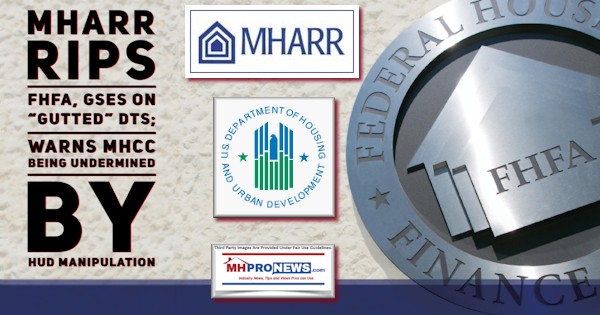
Conclusion
Concerns and even evidence are not proof, until adjudicated in a court of competent jurisdiction or settled by agreement of harmed parties. The numbers of potentially harmed parties are many, including, but not limited to, millions of current manufactured homeowners, thousands of independents, and others.
The irony might be that absent market manipulation that tends toward consolidation, the upside potential for ethical investment may well be greater. Because as Sun (SUI) recently stated, it is now often less costly to develop new sites than to buy existing ones.
Developing new sites and new communities, for those who know how to attract new manufactured home customers effectively and with solid conversion rates, is arguably better for the majority of the nation, not only for manufactured home independents and current homeowners. It is a simple matter of economics 101. There is plenty of housing demand. Supply isn’t being met. So long as new supply is coming online, it supports other housing values.
Without enough new housing and new home sites coming online, a variety of costly and problematic social ills occur.
So, while this is a manufactured housing issue, it has ripple effects throughout the economy.
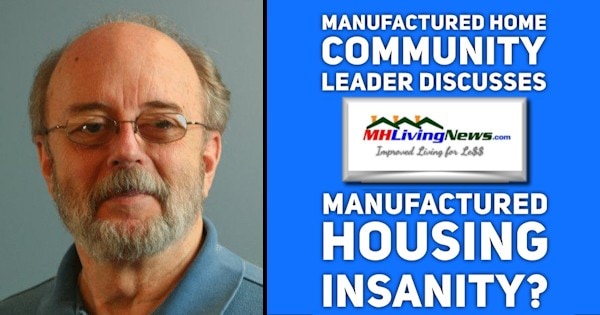
As resident leader Robert ‘Bob’ Van Cleef has dubbed it, what is occurring now is insanity, and it begs for federal and other investigations.
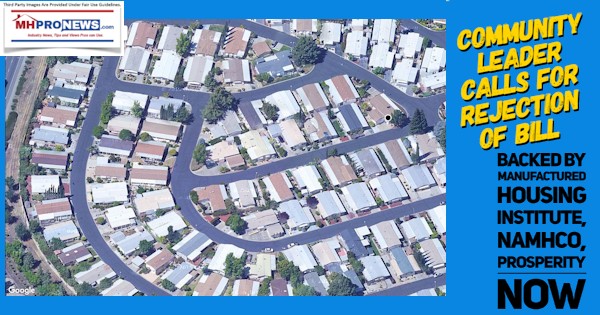
The industry could shed its black hat woes by taking appropriate action. White hat operations could set themselves apart from vulture capitalists by adopting the normal view that businesses need happy customers, and that comes from good service.
Who says? MHI’s prior president.


That’s a wrap on part two of a two part look at what the latest ELS data tells manufactured housing professionals, investors, advocates, and others. It is all found here at the biggest, most-read, #1 source for manufactured home industry “News, Tips, and Views Pros Can Use,” © where “We Provide, You Decide.” © ## (News, analysis, and commentary.)

Soheyla is a managing member of LifeStyle Factory Homes, LLC, the parent company to MHProNews, and MHLivingNews.com. Connect with us on LinkedIn here and and here.
Related Reports:
Click the image/text box below to access relevant, related information.
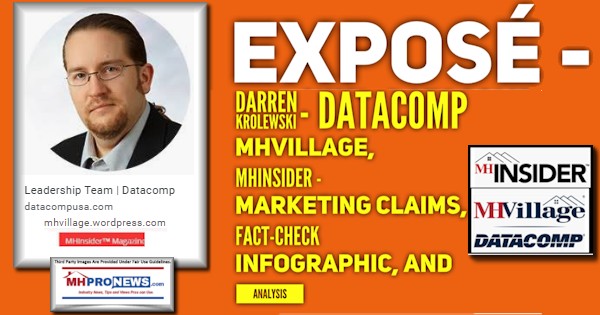
https://www.manufacturedhomepronews.com/masthead/expose-darren-krolewski-datacomp-mhvillage-mhinsider-marketing-claims-fact-check-infographic-and-analysis/

CBS Spotlights Manufactured Home Community Leader Video Interview
Site-Builder’s Videos Could Point Way For More Manufactured Home Sales

























